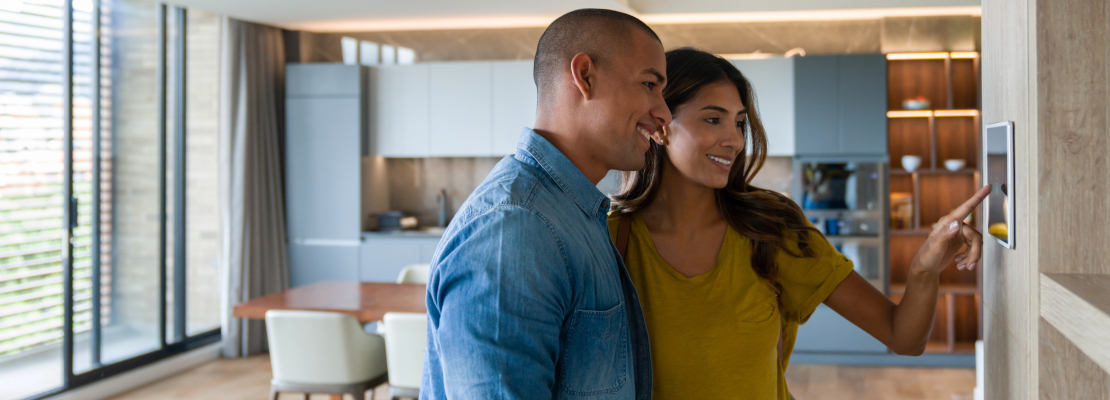Home improvements are usually made to fix a problem, improve functionality and/or appearance, and increase a home’s value. Improving a home can be a project as big as building out a basement or redoing an entire kitchen, or as small as painting a wall or adding a flower garden. A lot of home improvements can be done gradually, in stages, so costs, time, and effort can be spread out to be more manageable. With not too much money—say, approximately $150 or even a little less—it’s possible to undertake a few relatively easy and quick home improvements that can make a home more efficient and attractive and possibly, save the homeowner a bit of money.
What can you do for your home for about $150? Well, let’s see…
- You can be cool or getting warmer with a new, smart thermostat. There are smart thermostats available for less than $100, and they can save you money on heating and cooling costs. A smart thermostat is programmable; it lets you set a schedule to cool or warm your home and some can learn from your usage what temperatures you prefer at what times of the day. Automating your heating and air conditioning can save money depending on your use; for example, if no one is home during the day, the thermostat can set a temperature that you wouldn’t be comfortable with but that cuts down on energy costs. This automatic schedule can be especially helpful during a vacation if no one is home. Some smart thermostats can also be monitored and controlled from an app on your cellphone, so you can adjust the thermostat even when you’re not home.
- Get some traction on your stairs with friction tape—and make them less slippery. If you’ve got hard, uncarpeted steps inside or outside that are a little too smooth and therefore possibly unsafe, save yourself from potentially harmful falls down the stairs by investing in some non-slip tape. This should be less than $25 per roll, which is a small price for more safety. Non-slip tape—also known as friction tape—comes in a variety of widths for different applications, for both indoor and outdoor uses. Check the length of tape on each roll so you can get enough to cover one or more staircases. Hardware and home improvement stores carry non-slip tape, which is generally simple to install.
- Give your house the power of the sun with solar-powered outdoor yard lighting. For external doors, paths and porches, small posts of solar-powered LED lighting do not cost much, are easy to install and require no electricity from your home. These lights usually come as kits where you just need to insert the light posts into the ground and—maybe—angle the built-in solar panel for better sun exposure. These lights come in different styles, and they can make the yard and house more attractive and possibly safer as the ground is better lit at night.
- Paint a small room or a couple of walls. Painting an entire home can be expensive, but focusing on a single small room or one or two walls can cost under $150 after purchasing paint, brushes, rollers, drop cloths, paint thinner and other equipment.
- Re-caulk your bathtub, sinks and windows. Adding a new bead (a sealant line) of caulk around your bathtub, sink or windows prevents water and air leaks, saving costs from fixing water and mold damage or having to excessively heat or cool your home. There are different types of caulk, so research the appropriate type for your exact home improvement task.
- Supercharge your electrical outlets so they can do more; you can upgrade them with charging ports, lights and timers. If your electrical outlets are still the standard two socket model, they can be upgraded to add more functions with features such as USB charger ports, timers for automatically turning power on or off, motion sensors and wi-fi connectivity for more control over their actions. The new outlets shouldn’t require any rewiring, but if you’re switching them out yourself, then carefully follow all the installation instructions for a safe replacement, including always shutting off the home’s main circuit breaker power switch that cuts off all electricity to the outlet being upgraded.
- Planting flowers is a pretty nice improvement for any home; it’s not expensive and easy to do. Planting bright, colorful flowers in the front yard and backyard brightens the landscaping and makes the home more attractive overall. Flowers can go in a garden or anywhere around the house, including pathways, mailboxes, porches and other easily visible areas.
- Put felt pads under furniture feet to protect your floors. Putting soft, self-adhesive felt pads under the feet of chairs, sofas, couches, chests of drawers, coffee and end tables, and other furniture can help lessen wear and scratches on hardwood and linoleum floors. Follow the installation instructions for the protective pads, and always be careful when lifting heavy and unwieldy furniture.
- Add bumper pads to kitchen drawers to make them quieter. If kitchen (or other drawers) close a little too forcefully and loudly, then consider adding small, soft bumper pads to the sides of the drawer or the cabinet where they make physical contact. These self-adhesive pads are usually made of rubber, silicone, fabric or soft plastic, and absorb the shock of the closing drawer, making it quieter and putting less structural stress on the drawer since it is not banging into the cabinet repeatedly.
Looking for more advice on saving and spending money?
For more information that may help you manage your costs and finances, look into the free Delta Community Financial Education Center webinars on a range of practical, “how to” financial topics. Please visit the Financial Education Center's Events & Seminars page to review and register for its on-demand webinars.
The Credit Union’s blog has more information that could be educational and helpful:



